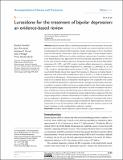Lurasidone for the treatment of bipolar depression: an evidence-based review
Author(s)
Deckersbach, Thilo; Widge, Alik; Franklin, Rachel; Zorowitz, Sam; Corse, Andrew
DownloadFranklin-2015-Lurasidone for the t.pdf (531.1Kb)
PUBLISHER_CC
Publisher with Creative Commons License
Creative Commons Attribution
Terms of use
Metadata
Show full item recordAbstract
Bipolar disorder (BD) is a debilitating and difficult-to-treat psychiatric disease that presents a serious burden to patients’ lives as well as health care systems around the world. The essential diagnostic criterion for BD is episodes of mania or hypomania; however, the patients report that the majority of their time is spent in a depressive phase. Current treatment options for this component of BD have yet to achieve satisfactory remission rates. Lurasidone is a drug in the benzisothiazole class approved by the US Food and Drug Administration in June 2013 for the acute treatment of bipolar depression. Its pharmacological profile features high-affinity antagonism at D[subscript 2], 5-HT[subscript 2A], and 5-HT[subscript 7] receptors; moderate-affinity antagonism at α[subscript 2C]-adrenergic receptors; low- to very low-affinity antagonism at α[subscript 1A]-adrenergic, α[subscript 2A]-adrenergic, H[subscript 1], M[subscript 1], and 5-HT[subscript 2C] receptors; and high-affinity partial agonism at 5-HT1A. Preliminary findings from two recent double-blinded clinical trials suggest that lurasidone is efficacious in treating bipolar I depression, with clinical effects manifesting as early as the first 2–3 weeks of treatment (as measured by the Montgomery–Åsberg Depression Rating Scale and Clinical Global Impressions Scale for use in bipolar illness). Its therapeutic benefit appears to be comparable to the current US Food and Drug Administration-indicated treatments: quetiapine and olanzapine–fluoxetine, according to a measure of effect size known as number needed to treat. These studies reported relatively limited extrapyramidal and metabolic side effects as a result of treatment with lurasidone, with the most common side effect being nausea. Safety data drawn from these studies, as well as a more extensive body of schizophrenia research, indicate that in comparison with other atypical antipsychotics, treatment with lurasidone is less likely to result in metabolic side effects such as weight gain or disturbances of serum glucose or lipid levels. Lurasidone holds clinical potential as a novel, efficacious pharmacological treatment for bipolar depression. However, current data on its use for the treatment of BD are limited, and more extensive research, both longer in duration as well as independently conducted, is needed.
Date issued
2015-08Department
Picower Institute for Learning and MemoryJournal
Neuropsychiatric Disease and Treatment
Publisher
Dove Medical Press
Citation
Deckersbach, Thilo, Alik Widge, Rachel Franklin, Sam Zorowitz, and Andrew Corse. “Lurasidone for the Treatment of Bipolar Depression: An Evidence-Based Review.” Neuropsychiatric Disease and Treatment (August 2015): 2143.
Version: Final published version
ISSN
1178-2021
1176-6328